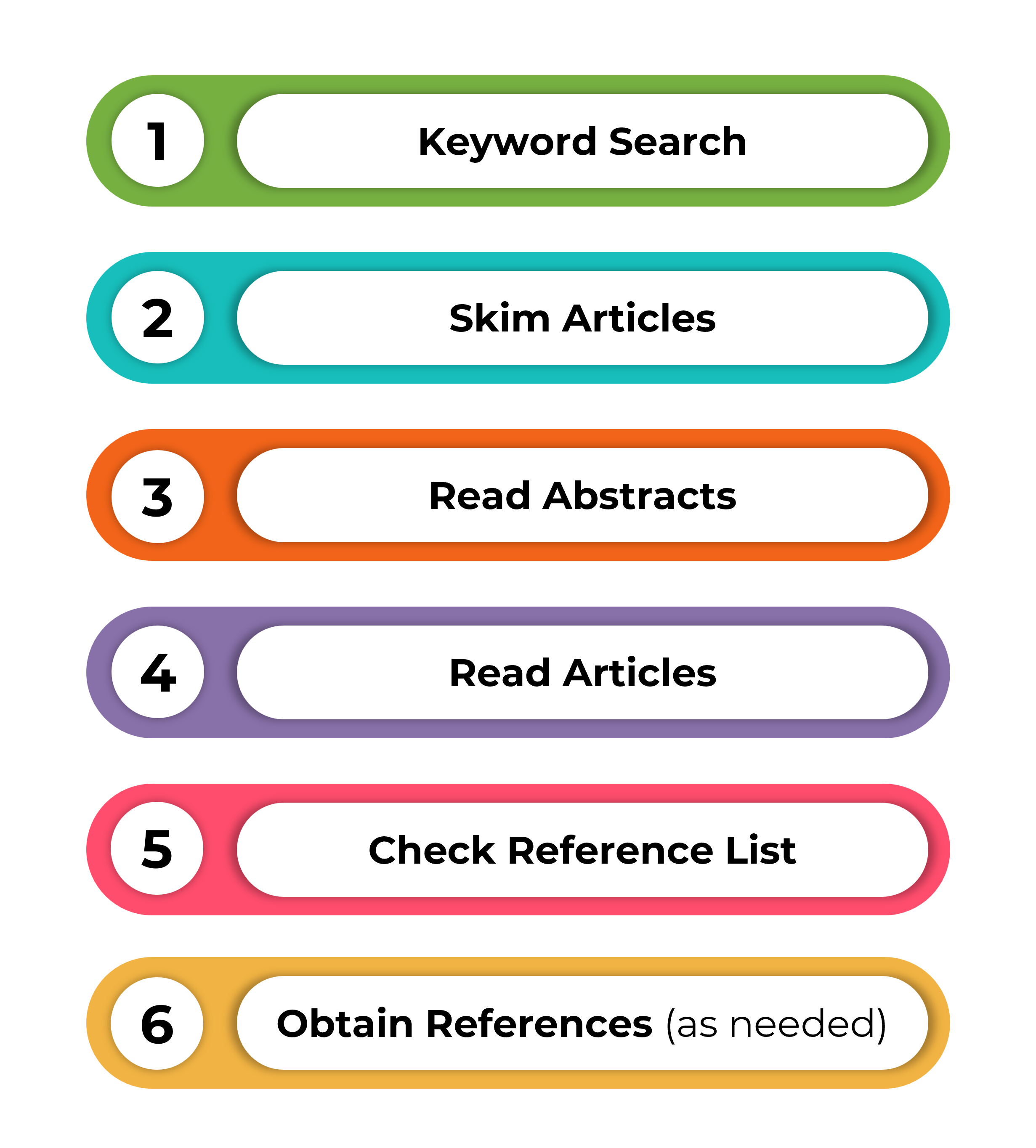Tips for Conducting a Review of the Literature
Luke Duesbery and Todd Twyman (2020) offer some advice for doing an efficient literature review.
Caution
Focus
Timeliness
Counter-arguments
Primary Sources
Simplify
Reading a Research Article
Steps:
- Keyword search
- Skim articles
- Read abstracts
- Read articles
- Check reference lists
- Obtain references (as needed)

After conducting a keyword search and finding literature,
- Start by skimming the articles to identify those most relevant to your research topic or question. Skimming involves quickly reading to assess the potential usefulness of each article.
- Pay special attention to the abstracts, as they summarize the study’s main questions and findings.
- If an abstract suggests the article is highly relevant to your research, read the article in detail to decide if it should be included in your research sources.
- Also, check the reference lists of these articles for additional relevant titles.
- If you find promising sources in these lists, obtain and read them to evaluate their relevance and usefulness for your research.
Structure of a Research Article
Most research articles have a similar structure. Being familiar with the structure of research articles will help you know where to look for what in the article.
- Abstract:
Summary of the aims/method/results - Introduction:
General introduction into the topic - Literature Review:
Summary of previous relevant research and identification of research gaps - Method:
Description of how the research was conducted (participants/procedure/data analysis) - Results:
Summary of the significant findings (often includes tables/figures/statistics etc.) - Discussion:
Interpretation of main findings concerning data and the literature - Conclusion:
Summary of main findings/implications/limitations
References: Research cited
For each study you review, encapsulate it into a brief summary that reflects any aspect of the study that has relevance to your topic.
This may include
- the variable studied,
- the methodology employed,
- the participants studied, and
- the conclusions obtained.
Note:
Remember, however, to emphasize the research findings – that is what will influence your study most.
Video
Identify Themes and Gaps in Literature
The following video will help you as you review the literature relevant to your research topic.
Source: Scribbr. YouTube, 23 Apr 2020.
Evaluating the Literature
Once sources are chosen they must be further evaluated to determine how the reviewed information can be used to guide your action research project (Hendricks, 2013).
Questions to ask in evaluating the literature include the following:
Relevance
Does the source provide information that can help inform my action research study?
Credibility
Does the source seem credible? If the source is not a research study, are the claims and/or suggestions made by the author based on his or her extensive experience?
Similarity
Is the information in the source based on the study of a setting that is similar to mine?
Synthesizing the Relevant Literature
Once sources have been chosen based on their relevance, credibility, and similarity to the action research study the next step is to synthesize information. Synthesizing involves connecting information into a coherent, integrated whole. This is done when all the relevant sources have been thoroughly read.
Reflective Activity
Reflect
Using the documentation tool below, write both your proposed action research topic and the keywords in your action research question.
Example:
Proposed Action Research Question:
“How can online polling increase student engagement during lectures?”Keywords in Action Research Question: Online Polling, Engagement, Lectures

